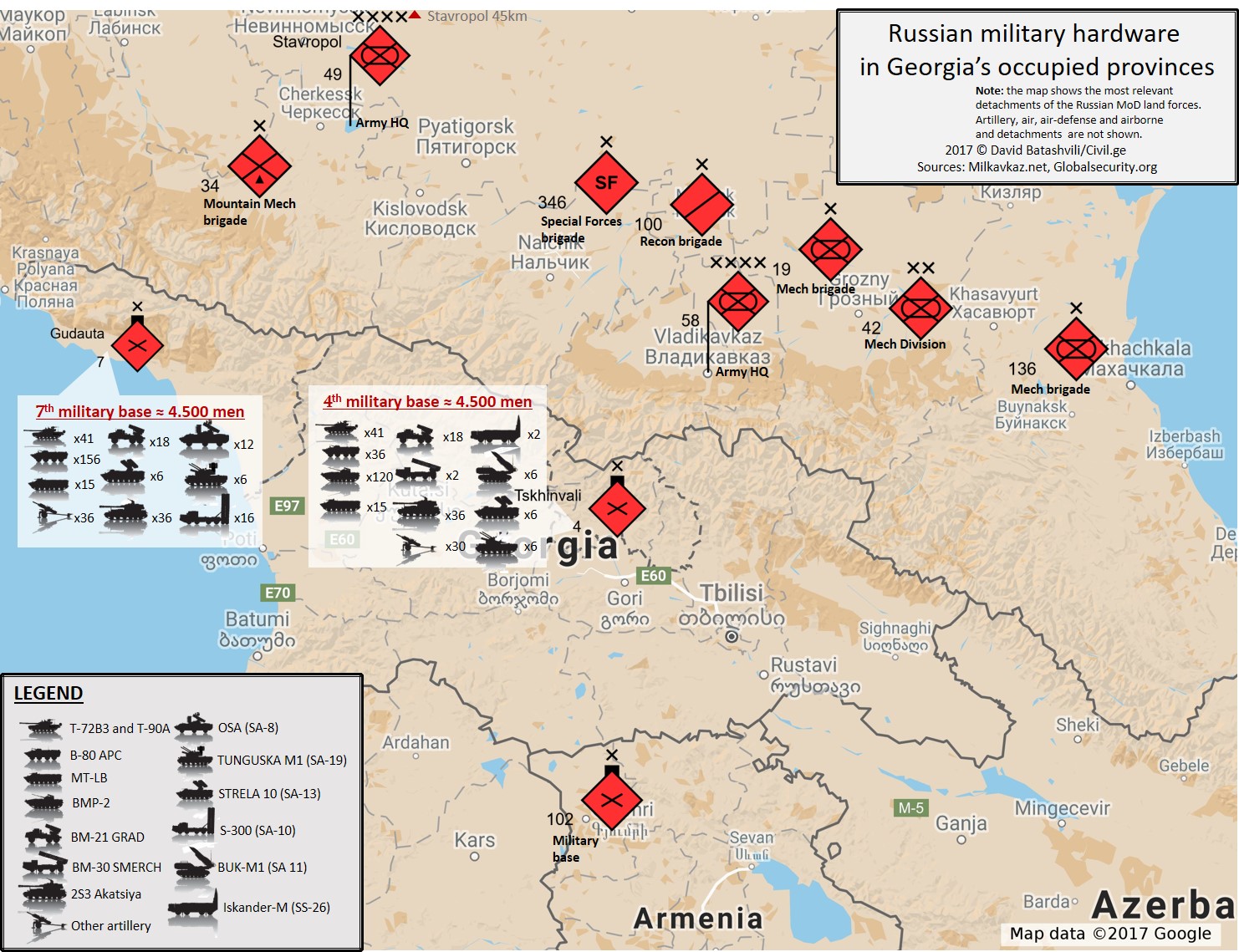The UN Security Council has held a discussion on 28 March 2017, with most members concerned about Russia’s recent moves in Georgia, and specifically the merger of the Tskhinvali regime military units under the Russian command. These events must bring to the fore the actual size of the aggressive Russian military deployment in and around Georgia, which often fades into the background of conversations about peaceful resolution.
Russia’s military posture is offensive. According to Russian Defense Minister Sergey Shoygu, the significant bolstering of military capability in the south is linked to “the build-up of NATO military presence in Eastern Europe, the situation in Ukraine and the activities of international terrorist groups, including the North Caucasus.” Consequently, Kavkaz-2016 military drills in September 2016 have practiced theater-level command tasks of every type of unit in a coordinated combined arms setting, involving some 12,500 troops – also in Abkhazia and Tskhinvali Region.
The size and character of deployments, their posture and the political context are menacing for Georgia, which aims towards closer integration with the NATO. Positioning, numbers and hardware of the Russian military near and within Georgia leave no doubt that Russia keeps the option of a military attack on Georgia open. This reality cannot be ignored, as Georgia and its Western partners seek to advance peace.
Russian military forces within Georgia
Russia has thoroughly militarized Abkhazia and Tskhinvali regions of Georgia, which it has fully occupied as a result of the war in August 2008.

Their force structure and composition goes against their purported objective of guarding against potential Georgian aggression. These forces are capable of undertaking an offensive operation against Georgia, especially using the detachments in Tskhinvali region, and providing support to a larger scale offensive involving the Russian military based outside Georgia’s borders. The key regional center – Gori – and Georgia’s main East-West highway are within the range of the artillery systems. The two bases combined include:
• more than eight thousand Russian soldiers,
• over 80 tanks (more than half of these are T-90A models in Abkhazia, the rest are modernized T-72B3 models),
• over 370 armored vehicles (130 are recently modernized BTR-82AM),
• 36 BM-21 Grad multiple rocket launchers,
• 72 self-propelled 2S3 Akatsiya 152mm artillery systems,
• 54 other artillery pieces.
The Russian MoD has also supplied their forces in Georgia with high grade offensive weapons. Tbilisi, Georgia’s capital, is well within the firing range of these systems:
• a battery of 9K720 Iskander-M ballistic missiles (NATO specification SS-26 Stone) with the range of between 400 and 500 kilometers; the missiles can be equipped with cluster, fuel-air explosive, bunker-busting and electro-magnetic pulse conventional warheads, as well as tactical nuclear warheads.
• BM-30 Smerch multiple rocket launchers with 90 kilometers of range.
Another important item of Russian weaponry that has been placed in the occupied Georgian regions is the S-300 (SA-10 Grumble) air defense missile systems, stationed in Abkhazia. They can play an important role in deterring Georgia’s allies in case of a Russian attack in the Anti-Access/Area Denial (A2/AD) role. Russia deployed similar systems, as well as anti-ship K-300P Bastion (SS-C-5 Stooge) following the occupation of Crimea in early 2014, as it went on with its attempt to break-up Ukrainian sovereignty in the eastern and southern regions of that country, beyond Crimea.
The integration of the local troops under joint (i.e. Russian) command further increases both number and agility of the deployed forces. Through creation of the Unified Group of Forces with the Sukhumi armed units , the Russian 7th Military Base in Abkhazia has been in command of additional local forces since 2015. In March 2017 incorporation of Tskhinvali’s armed units into the Russian army was under way as well.
During the war in August 2008, offensive of the Russian forces was augmented by combined operations with the Tskhinvali and Sukhumi armed groups, which were trained by and achieved interoperability with the Russian forces – deployed in both regions under the guise of peacekeepers – well in advance, as a part of plans of military operation against Georgia drawn since at least late 2006. The present Russian policy of institutional incorporation of these local forces into its army builds on and re-enforces this arrangement in the case of any future military action.
Russian military forces near Georgia
The Russian bases stationed within Georgia’s occupied provinces are a component of the general, strategic force projection and offensive capabilities in the whole southern theater of operation, the main parts of which are positioned near Georgia’s borders.
Both 7th (Abkhazia) and 4th (Tskhinvali) military bases administratively fall under the Southern Military District (SMD) and operationally under the 49th and 58th Armies (HQ in Stavropol and Vladikavkaz, respectively). The bulk of SMD forces are stationed in Russia’s North Caucasus. The district also includes Russian forces in Armenia (102nd base in Gyumri and the military airport in Yerevan) as well as forces in Crimea and Sevastopol.
In recent years, the SMD is being consistently strengthened. In July 2016 Russian Defense Minister Sergei Shoigu transferred the chief of the Syrian operation, Colonel-General Alexander Dvornikov to head the District.
After the war of 2008, Russia reformed its military structure. It rejected the divisions of about 10 thousand soldiers, and opted for more agile brigades, mirroring the NATO troop structure. Since the start of the war in Ukraine, however, the Russians have reversed this course, and began re-establishing divisions that are considered more suitable for large-scale, conventional frontal combat. The first two divisions were established near Moscow. Apparently satisfied with the results, the Russian military has been establishing five more divisions in 2016-2017. Three of them are near the Ukrainian border, another one - in the Ural region, and another - the 42nd Mechanized Division - in the eastern North Caucasus. In August 2008 the 42nd Division was the main force of the invasion, crossing into Georgia after the Russian vanguard units.
The 42nd Division and other Russian forces based within 250 kilometers of Georgia’s border currently include tens of thousands of soldiers with: over 200 tanks – most of them T-90A or the modernized T-72B3 models, with 41 tanks being the T-90; over 1700 armored vehicles; over 500 artillery pieces; almost 130 multiple rocket launchers – majority of them BM-21 Grad, but also the more powerful BM-27 Uragan, Tornado-G (upgraded BM-21) and thermobaric TOS-1A systems.
In 2013-2016 the Russian military bolstered its Iskander tactical missile forces in the North Caucasus. A whole new 12th Missile Brigade was established, while the 1st Missile Brigade, already based in the region, has fully transitioned to Iskanders, to replace the older, Tochka-U (Scarab B) systems. Currently, there are 24 Iskander short-range ballistic missile systems in these two missile brigades.
The Russian MoD is presently launching a new reconnaissance brigade in the North Caucasus. That follows establishment in the region of a brigade and a separate regiment of Special Forces in 2011-2012, and a reconnaissance brigade in 2009, in addition to the Southern Military District’s two older Special Forces brigades that participated in the war against Georgia in 2008. Another part of the effort to strengthen the capabilities of forces based in the Caucasus is the establishment of a tank unit within the 7th Air Assault Brigade.
In addition, in Gyumri, Armenia the Russian ground forces constitute an equivalent of a mechanized brigade. Similarly to the Russian bases in the occupied Georgian regions, Moscow supplied its Armenian base with S-300, Iskander and Smerch systems. Gyumri is located about 35 kilometers from Georgia’s southern border.
Experience tells us that during a Russian invasion the airborne troops (VDV) from central Russia join the locally based units in the first wave of attack. They can also be joined by other forces from the parts of Russia beyond the Caucasus region – both the Special Forces and heavier units sent by railroad.
* * * *
Georgia’s strategic military situation is worse today than it was in 2008. Strong and heavily armed Russian forces, many of which have seen real combat, are now well-established within the occupied Abkhazia and Tskhinvali regions. Those forces are very close to Georgia’s main cities and even closer to its vital lines of communication, such as the main East-West highway. In the Caucasus region as a whole, the Russian military are equipped with more lethal and modern weapons than before, and their level of preparedness is kept at a higher level through multiple drills, including large-scale ones such as “Kavkaz-2016”.
The Kremlin continues to signal that it views the sovereign Georgian foreign policy aimed at the Euro-Atlantic integration as unacceptable. With the Russian military emboldened by its successful military adventures abroad, Georgia finds itself in a precarious position.
David Batashvili (@DavidBatashvili) is an international relations analyst. He worked for the National Security Council of Georgia in 2008-2013.
UPDATED 7 April 2017: Map cartography now matches NATO APP6 standard closer. Confirmed presense of T90A main battle tank variants reflected on the map.

 RSS
RSS Mobile
Mobile Twitter
Twitter Facebook
Facebook